Recent Advances in the Synthesis of Isoquinoline-Fused Benzimidazoles
Abstract
:1. Introduction
2. Ring B Formation
3. Ring C Formation
4. Ring B and C Formation
5. Ring B and C Formation Using o-Phenylenediamines
6. Crystallographically Characterized Benzimidazo[2,1-a]isoquinolines
7. Summary and Conclusions
Author Contributions
Funding
Acknowledgments
Conflicts of Interest
References
- Sun, Q.; LaVoie, E.J. Synthesis of Benzimidazo[2,1-a]isoquinolines and 5,6-Dihydrobenzimidazo[2,1-a]isoquinolines. Heterocycles 1996, 43, 737–743. [Google Scholar] [CrossRef]
- Lu, Z.X.; Quazi, N.H.; Deady, L.W.; Polya, G.M. Selective Inhibition of Cyclic AMP-Dependent Protein Kinase by Isoquinoline Derivatives. Biol. Chem. Hoppe-Seyler 1996, 377, 373–384. [Google Scholar] [CrossRef] [PubMed]
- Deady, L.W.; Rodemann, T.; Finlay, G.J.; Baguley, B.C.; Denny, W.A. Synthesis and cytotoxic activity of carboxamide derivatives of benzimidazo[2,1-a]isoquinoline and pyrido[3’,2’:4,5]imidazo[2,1-a]isoquinoline. Anti-Cancer Drug Des. 2000, 15, 339–346. Available online: https://www.ingentaconnect.com/contentone/cog/antcan/2000/00000015/00000005/art00005 (accessed on 16 February 2022).
- Garrett, C.E.; Prasad, K. The Art of Meeting Palladium Specifications in Active Pharmaceutical Ingredients Produced by Pd-Catalyzed Reactions. Adv. Synth. Catal. 2004, 346, 889–900. [Google Scholar] [CrossRef]
- Miao, W.-Q.; Liu, J.-Q.; Wang, X.-S. An efficient synthesis of 6-arylbenzo[4,5]imidazo[2,1-a]isoquinolines via sequential α-arylation of carbonyl and deacylation catalyzed by CuI. Org. Biomol. Chem. 2017, 15, 5325–5331. [Google Scholar] [CrossRef] [PubMed]
- Yang, B.W.; Dao, P.D.Q.; Yoon, N.S.; Cho, C.S. Copper-catalyzed C-C coupling and cyclization: Synthesis of benzo[4,5]imidazo[1,2-a]pyridines and benzo[4,5]imidazo[2,1-a]isoquinolines. J. Organomet. Chem. 2017, 851, 136–142. [Google Scholar] [CrossRef]
- Liu, H.; Li, Z. Copper-Catalyzed Construction of Benzo[4,5]imidazo[2,1-a]isoquinolines Using Calcium Carbide as a Solid Alkyne Source. Org. Lett. 2021, 23, 8407–8412. [Google Scholar] [CrossRef]
- Peng, J.; Shang, G.; Chen, C.; Miao, Z.; Li, B. Nucleophilic Addition of Benzimidazoles to Alkynyl Bromides/Palladium-Catalyzed Intramolecular C–H Vinylation: Synthesis of Benzo[4,5]imidazo[2,1-a]isoquinolines. J. Org. Chem. 2013, 78, 1242–1248. [Google Scholar] [CrossRef]
- Cheng, J.; Yang, R.; Wu, X.; Sun, S.; Yu, J.-T. Rhodium-Catalyzed Annulation of 2-Arylimidazoles and α-Aroyl Sulfoxonium Ylides toward 5-Arylimidazo[2,1-a]isoquinolines. Synthesis 2018, 50, 3487–3492. [Google Scholar] [CrossRef]
- Mai, S.; Luo, Y.; Huang, X.; Shu, Z.; Li, B.; Lan, Y.; Song, Q. Diversity-oriented synthesis of imidazo[2,1-a]isoquinolines. Chem. Commun. 2018, 54, 10240–10243. [Google Scholar] [CrossRef]
- Tang, Z.; Mai, S.; Zhou, Y.; Song, Q. Divergent synthesis of α-aryl ketones/esters via rhodium-catalyzed selective deesterification and decarbonylation of diazo compounds. Org. Chem. Front. 2018, 5, 2583–2587. [Google Scholar] [CrossRef]
- Dutta, P.K.; Sen, S. (Benz)Imidazole-Directed Cobalt(III)-Catalyzed C-H Activation of Arenes: A Facile Strategy to Access Polyheteroarenes by Oxidative Annulation. Eur. J. Org. Chem. 2018, 2018, 5512–5519. [Google Scholar] [CrossRef]
- Obata, A.; Sasagawa, A.; Yamazaki, K.; Ano, Y.; Chatani, N. Nickel-catalyzed oxidative C–H/N–H annulation of N-heteroaromatic compounds with alkynes. Chem. Sci. 2019, 10, 3242–3248. [Google Scholar] [CrossRef] [PubMed] [Green Version]
- Kavitha, N.; Sukumar, G.; Kumar, V.P.; Mainkar, P.S.; Chandrasekhar, S. Ruthenium-catalyzed benzimidazoisoquinoline synthesis via oxidative coupling of 2-arylbenzimidazoles with alkynes. Tetrahedron Lett. 2013, 54, 4198–4201. [Google Scholar] [CrossRef]
- Yang, L.; Steinbock, R.; Scheremetjew, A.; Kuniyil, R.; Finger, L.H.; Messinis, A.M.; Ackermann, L. Azaruthena(II)-bicyclo[3.2.0]heptadiene: Key Intermediate for Ruthenaelectro(II/III/I)-catalyzed Alkyne Annulations. Angew. Chem. Int. Ed. 2020, 59, 11130–11135. [Google Scholar] [CrossRef]
- Karthik, S.; Ajantha, J.; Nagaraja, C.M.; Easwaramoorthi, S.; Gandhi, T. Synthesis and photophysics of extended π-conjugated systems of substituted 10-aryl-pyrenoimidazoles. Org. Biomol. Chem. 2016, 14, 10255–10266. [Google Scholar] [CrossRef]
- For related phenanthroimidazoloisoquinolines derivatives, see: Zheng, L.; Hua, R. Modular Assembly of Ring-Fused and π-Extended Phenanthroimidazoles via C–H Activation and Alkyne Annulation. J. Org. Chem. 2014, 79, 3930–3936. [Google Scholar] [CrossRef]
- For related phenanthroimidazoloisoquinolines derivatives, see: Yu, T.; Li, X.; Zhao, Y.; Yang, Q.; Li, Y.; Zhang, H.; Li, Z. Phenanthro[9′,10′:4,5]imidazo[2,1-a]isoquinoline derivatives containing phenoxazine moiety: Synthesis and photophysical properties. J. Photochem. Photobiol. A Chem. 2018, 360, 58–63. [Google Scholar] [CrossRef]
- For related arylimidazo[2,1-a]isoquinolines derivatives, see: Dias, G.G.; Paz, E.R.S.; Kadooca, J.Y.; Sabino, A.A.; Cury, L.A.; Torikai, K.; de Simone, C.A.; Fantuzzi, F.; da Silva Júnior, E.N. Rhodium(III)-Catalyzed C–H/N–H Alkyne Annulation of Nonsymmetric 2-Aryl (Benz)imidazole Derivatives: Photophysical and Mechanistic Insights. J. Org. Chem. 2021, 86, 264–278. [Google Scholar] [CrossRef]
- Ghosh, K.; Nishii, Y.; Miura, M. Rhodium-Catalyzed Annulative Coupling Using Vinylene Carbonate as an Oxidizing Acetylene Surrogate. ACS Catal. 2019, 9, 11455–11460. [Google Scholar] [CrossRef]
- Takagi, K.; Ito, K.; Yamada, Y.; Nakashima, T.; Fukuda, R.; Ehara, M.; Masu, H. Synthesis and Optical Properties of Excited-State Intramolecular Proton Transfer Active π-Conjugated Benzimidazole Compounds: Influence of Structural Rigidification by Ring Fusion. J. Org. Chem. 2017, 82, 12173–12180. [Google Scholar] [CrossRef] [PubMed]
- Sun, M.; Wu, H.; Zheng, J.; Bao, W. Palladium-Catalyzed Oxidative Intramolecular C-C Bond Formation via Double sp2 C-H Activation between the 2-Position of Imidazoles and a Benzene Ring. Adv. Synth. Catal. 2012, 354, 835–838. [Google Scholar] [CrossRef]
- Reddy, V.P.; Iwasaki, T.; Kambe, N. Synthesis of imidazo and benzimidazo[2,1-a]isoquinolines by rhodium-catalyzed intramolecular double C–H bond activation. Org. Biomol. Chem. 2013, 11, 2249–2253. [Google Scholar] [CrossRef] [PubMed] [Green Version]
- He, Y.; Huang, J.; Liang, D.; Liu, L.; Zhu, Q. C–H cycloamination of N-aryl-2-aminopyridines and N-arylamidines catalyzed by an in situ generated hypervalent iodine(iii) reagent. Chem. Commun. 2013, 49, 7352–7354. [Google Scholar] [CrossRef] [PubMed] [Green Version]
- Wang, H.; Wang, Y.; Peng, C.; Zhang, J.; Zhu, Q. A Direct Intramolecular C−H Amination Reaction Cocatalyzed by Copper(II) and Iron(III) as Part of an Efficient Route for the Synthesis of Pyrido[1,2-a]benzimidazoles fromN-Aryl-2-aminopyridines. J. Am. Chem. Soc. 2010, 132, 13217–13219. [Google Scholar] [CrossRef] [PubMed]
- Xie, H.; Xing, Q.; Shan, Z.; Xiao, F.; Deng, G.-J. Nickel-Catalyzed Annulation of o-Haloarylamidines with Aryl Acetylenes: Synthesis of Isoquinolone and 1-Aminoisoquinoline Derivatives. Adv. Synth. Catal. 2019, 361, 1896–1901. [Google Scholar] [CrossRef]
- Liu, X.; Deng, G.; Liang, Y. Selective synthesis of benzo[4,5]imidazo[2,1-a]isoquinolines via copper-catalyzed tandem annulation of alkynylbenzonitriles with 2-Iodoanilines. Tetrahedron Lett. 2018, 59, 2844–2847. [Google Scholar] [CrossRef]
- Meng, Y.-Y.; Zhu, W.-J.; Song, Y.-Y.; Bu, G.-G.; Zhang, L.-J.; Xu, F. Rhodium(III)-Catalyzed Oxidative Annulation of Amidines with Alkynes via Sequential C−H Bond Activation. Eur. J. Org. Chem. 2021, 2021, 1290–1294. [Google Scholar] [CrossRef]
- Xu, F.; Song, Y.-Y.; Zhu, W.-J.; Liu, C.-S.; Lu, Y.-Z.; Du, M. Rhodium-catalyzed multiple C–H activation/highlymeta-selective C–H amination between amidines and alkynes. Chem. Commun. 2020, 56, 11227–11230. [Google Scholar] [CrossRef]
- Dyker, G.; Stirner, W.; Henkel, G. Oxidative Heterocyclization of 2-Alkynylbenzaldehydes with 1,2-Phenylenediamine. Eur. J. Org. Chem. 2000, 2000, 1433–1441. [Google Scholar] [CrossRef]
- Analogous, metal-free synthesis of benzimidazo[2,1-a]ellipticines (DMF, 100 °C, 2 h) was reported: Chaitanya, T.K.; Prakash, K.S.; Nagarajan, R. Metal-free synthesis of benzimidazo[2,1-a]ellipticines via tandem inter and intramolecular cyclization. Tetrahedron 2011, 67, 6934–6938. [Google Scholar] [CrossRef]
- Okamoto, N.; Sakurai, K.; Ishikura, M.; Takeda, K.; Yanada, R. One-pot concise syntheses of benzimidazo[2,1-a]isoquinolines by a microwave-accelerated tandem process. Tetrahedron Lett. 2009, 50, 4167–4169. [Google Scholar] [CrossRef]
- Rustagi, V.; Tiwari, R.; Verma, A.K. AgI-Catalyzed Cascade Strategy: Regioselective Access to Diversely Substituted Fused Benzimidazo[2,1-a]isoquinolines, Naphthyridines, Thienopyridines, and Quinoxalines in Water. Eur. J. Org. Chem. 2012, 2012, 4590–4602. [Google Scholar] [CrossRef]
- Mishra, M.; Twardy, D.; Ellstrom, C.; Wheeler, K.A.; Dembinski, R.; Török, B. Catalyst-free ambient temperature synthesis of isoquinoline-fused benzimidazoles from 2-alkynylbenzaldehydes via alkyne hydroamination. Green Chem. 2019, 21, 99–108. [Google Scholar] [CrossRef]
- Sonawane, A.D.; Sonawane, R.A.; Win, K.M.N.; Ninomiya, M.; Koketsu, M. In situ air oxidation and photophysical studies of isoquinoline-fused N-heteroacenes. Org. Biomol. Chem. 2020, 18, 2129–2138. [Google Scholar] [CrossRef] [PubMed]
- Ouyang, H.-C.; Tang, R.-Y.; Zhong, P.; Zhang, X.-G.; Li, J.-H. CuI/I2-Promoted Electrophilic Tandem Cyclization of 2-Ethynylbenzaldehydes with ortho-Benzenediamines: Synthesis of Iodoisoquinoline-Fused Benzimidazoles. J. Org. Chem. 2011, 76, 223–228. [Google Scholar] [CrossRef]
- Bagdasarian, A.L.; Nguyen, H.H.; Palazzo, T.A.; Fettinger, J.C.; Haddadin, M.J.; Kurth, M.J. One-Pot Synthesis of Benzo[4,5]imidazo[2,1-a]isoquinolines and Isoquinolino[3,4-b]quinoxalines via Tandem Cyclization Strategies. J. Org. Chem. 2016, 81, 3924–3928. [Google Scholar] [CrossRef]
- Deady, L.W.; Loria, P.M.; Rodemann, T. Studies on the Synthesis of Benzimidazo[2,1-a]isoquinolines. Aust. J. Chem. 1998, 51, 941–946. [Google Scholar] [CrossRef]
- Borkin, D.A.; Puscau, M.; Carlson, A.; Solan, A.; Wheeler, K.A.; Török, B.; Dembinski, R. Synthesis of diversely 1,3,5-trisubstituted pyrazoles via 5-exo-dig cyclization. Org. Biomol. Chem. 2012, 10, 4505–4508. [Google Scholar] [CrossRef]
- Solan, A.; Nişanci, B.; Belcher, M.; Young, J.; Schäfer, C.; Wheeler, K.A.; Török, B.; Dembinski, R. Catalyst-free chemo-/regio-/stereo-selective amination of alk-3-ynones. Synthesis of 1,5-benzodiazepines and 3-amino-2-alkenones. Green Chem. 2014, 16, 1120–1124. [Google Scholar] [CrossRef]
- Young, J.; Schäfer, C.; Solan, A.; Baldrica, A.; Belcher, M.; Nişanci, B.; Wheeler, K.A.; Trivedi, E.A.; Török, B.; Dembinski, R. Regioselective “hydroamination” of alk-3-ynones with non-symmetrical o-phenylenediamines. Synthesis of diversely substituted 3H-1,5-benzodiazepines via (Z)-3-amino-2-alkenones. RSC Adv. 2016, 6, 107081–107093. [Google Scholar] [CrossRef]
- CCDC. Available online: www.ccdc.cam.ac.uk (accessed on 10 January 2022).
- Schäfer, C.; Cho, H.; Török, B. Green Synthesis of Common Heterocycles. In Green Chemistry in Drug Discovery: From Academia to Industry; Le, P.T., Richardson, P.F., Eds.; Springer: Berlin/Heidelberg, Germany, 2022; pp. 3–33. [Google Scholar] [CrossRef]
- Schäfer, C.; Cho, H.; Vlocskó, R.B.; Xie, G.; Török, B. Recent Advances in the Green Synthesis of Heterocycles: From Building Blocks to Biologically Active Compounds. Curr. Org. Synth. 2022, 17. (Online ahead of print). [Google Scholar] [CrossRef] [PubMed]





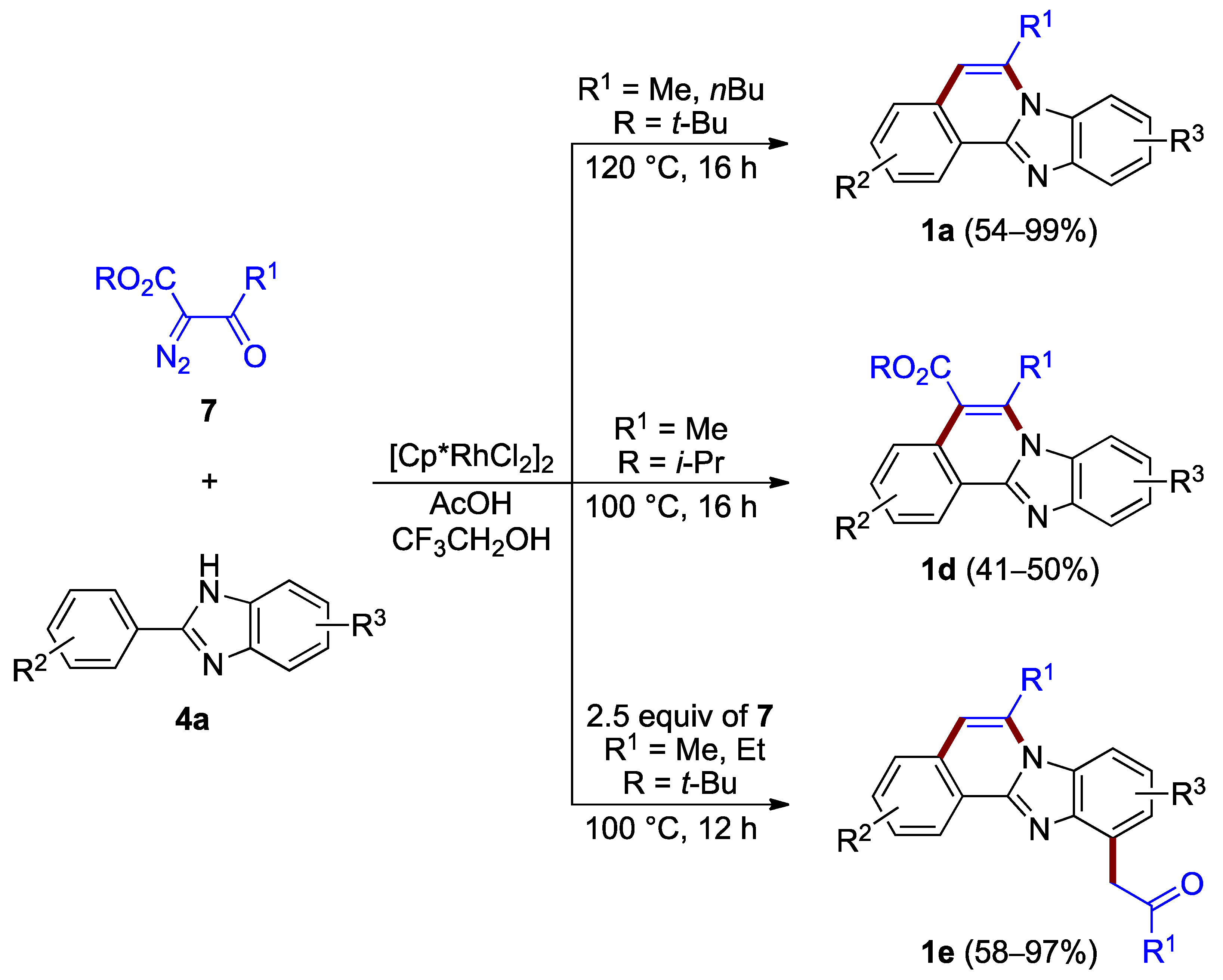
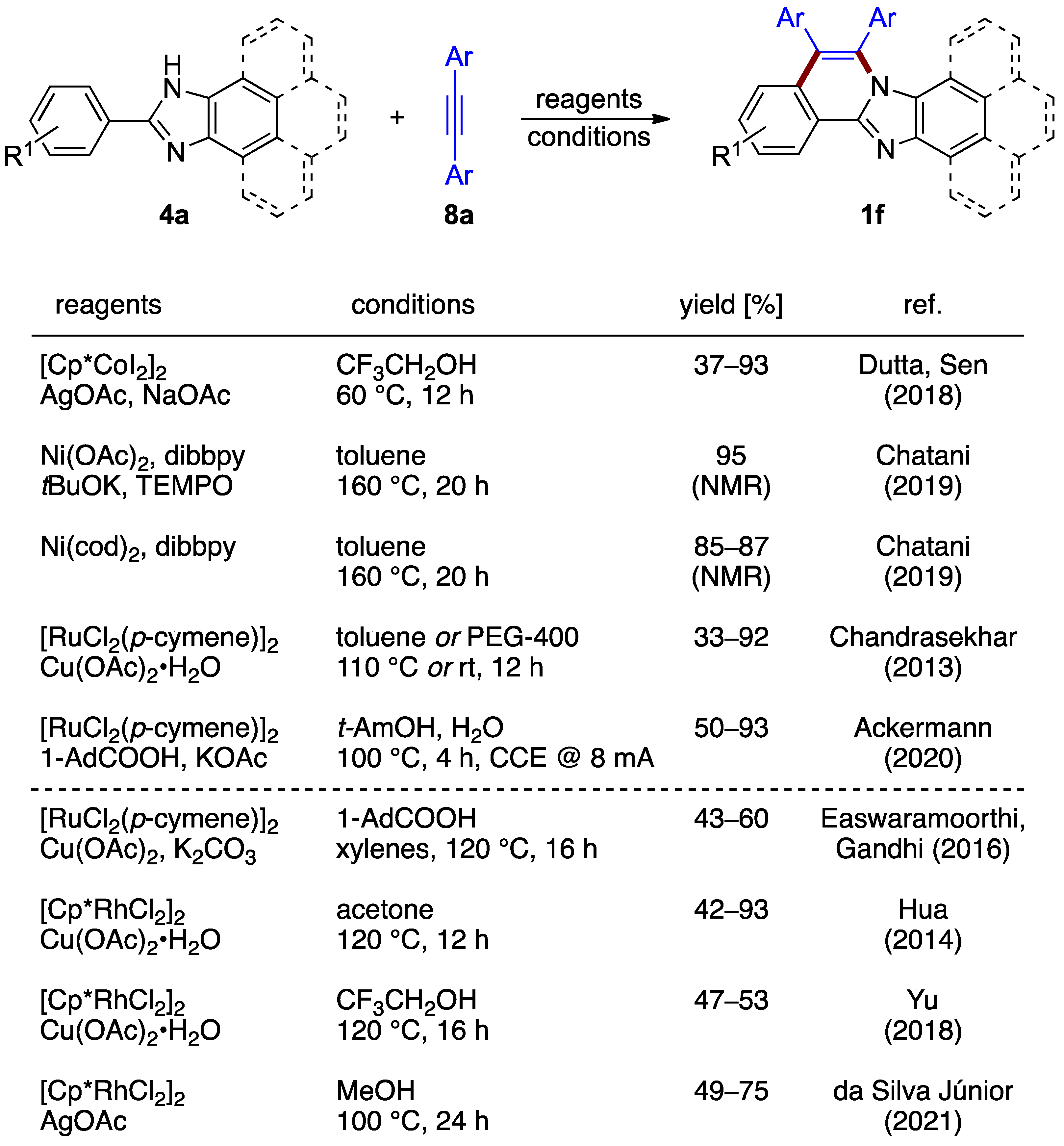


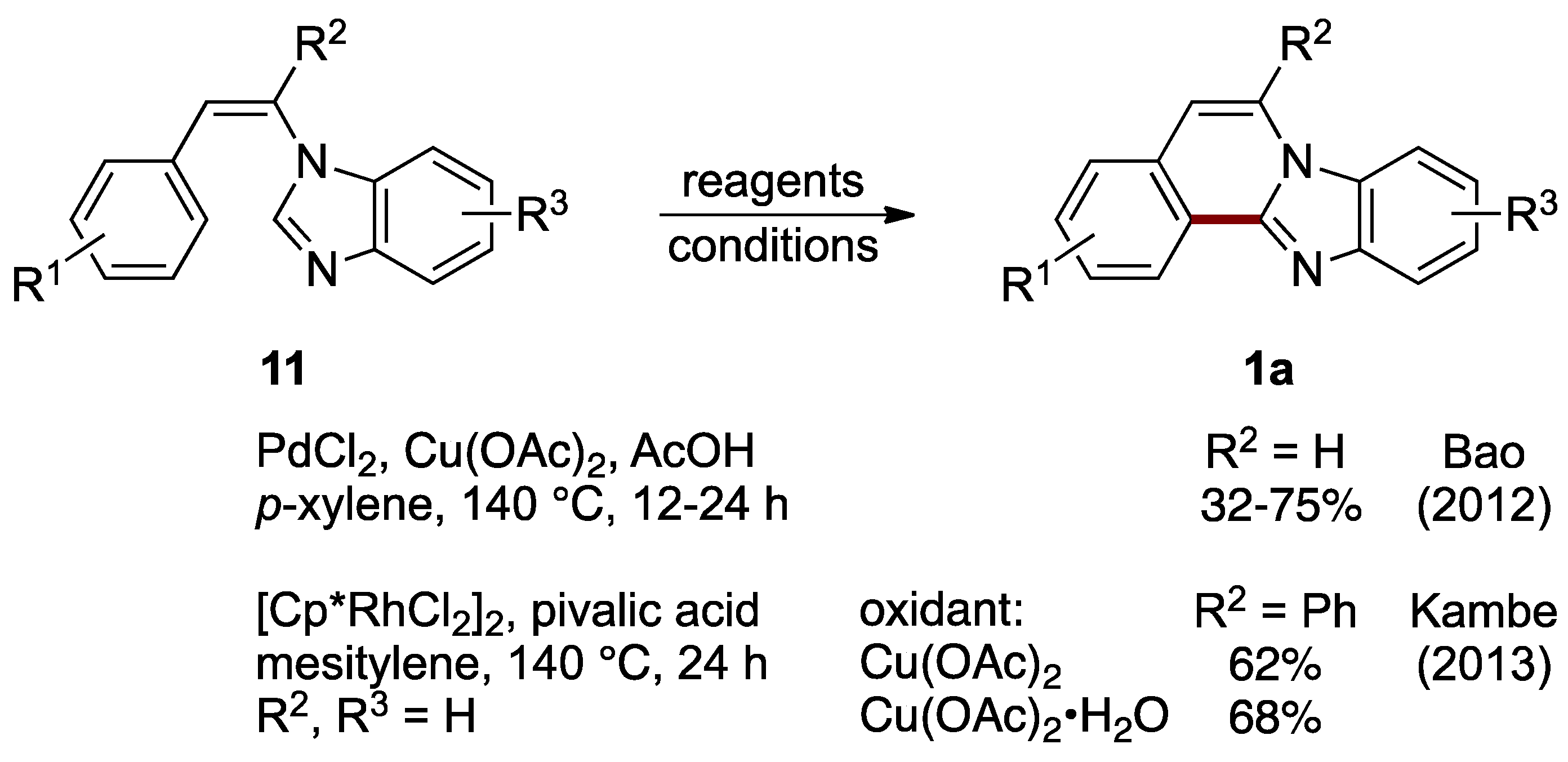



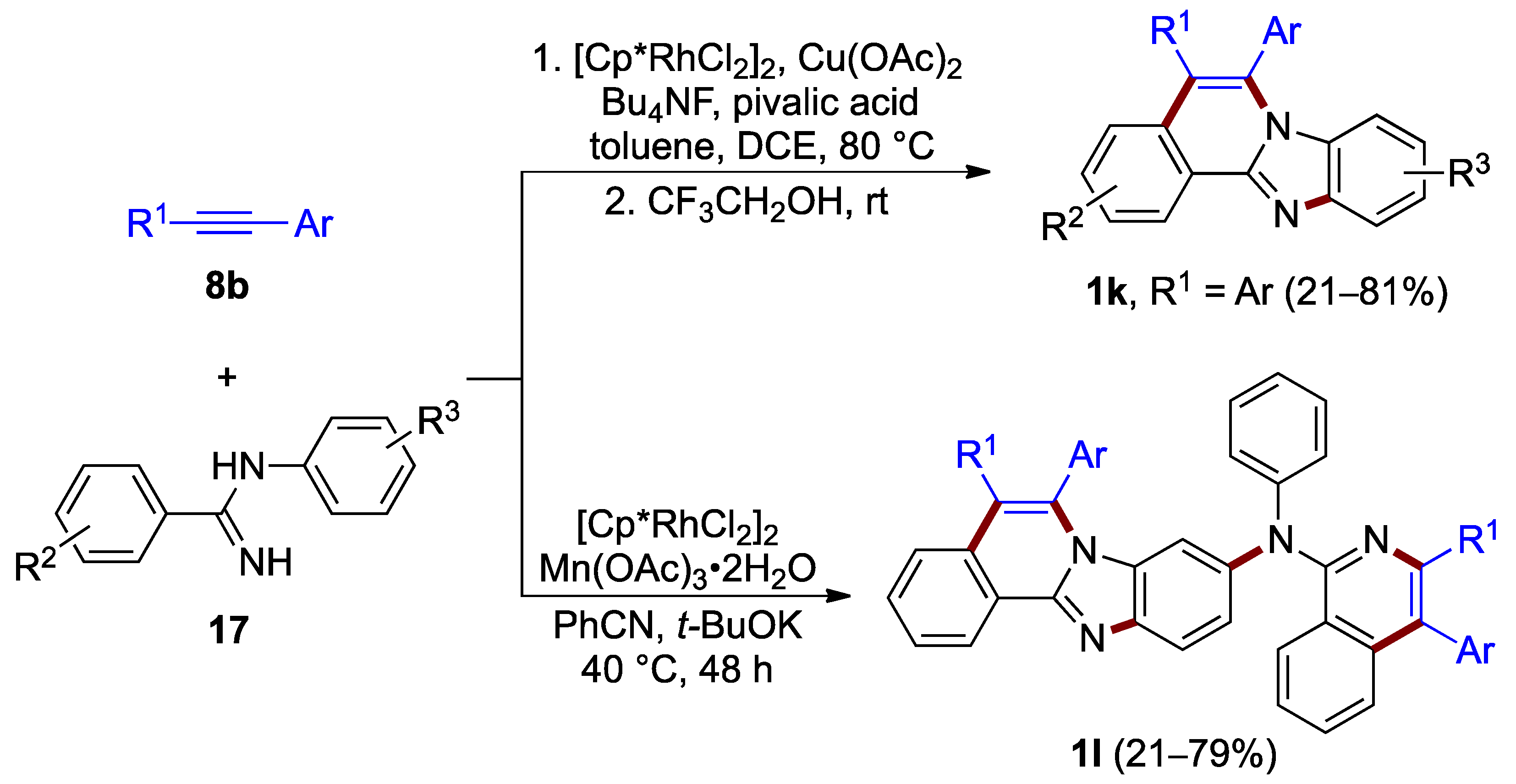
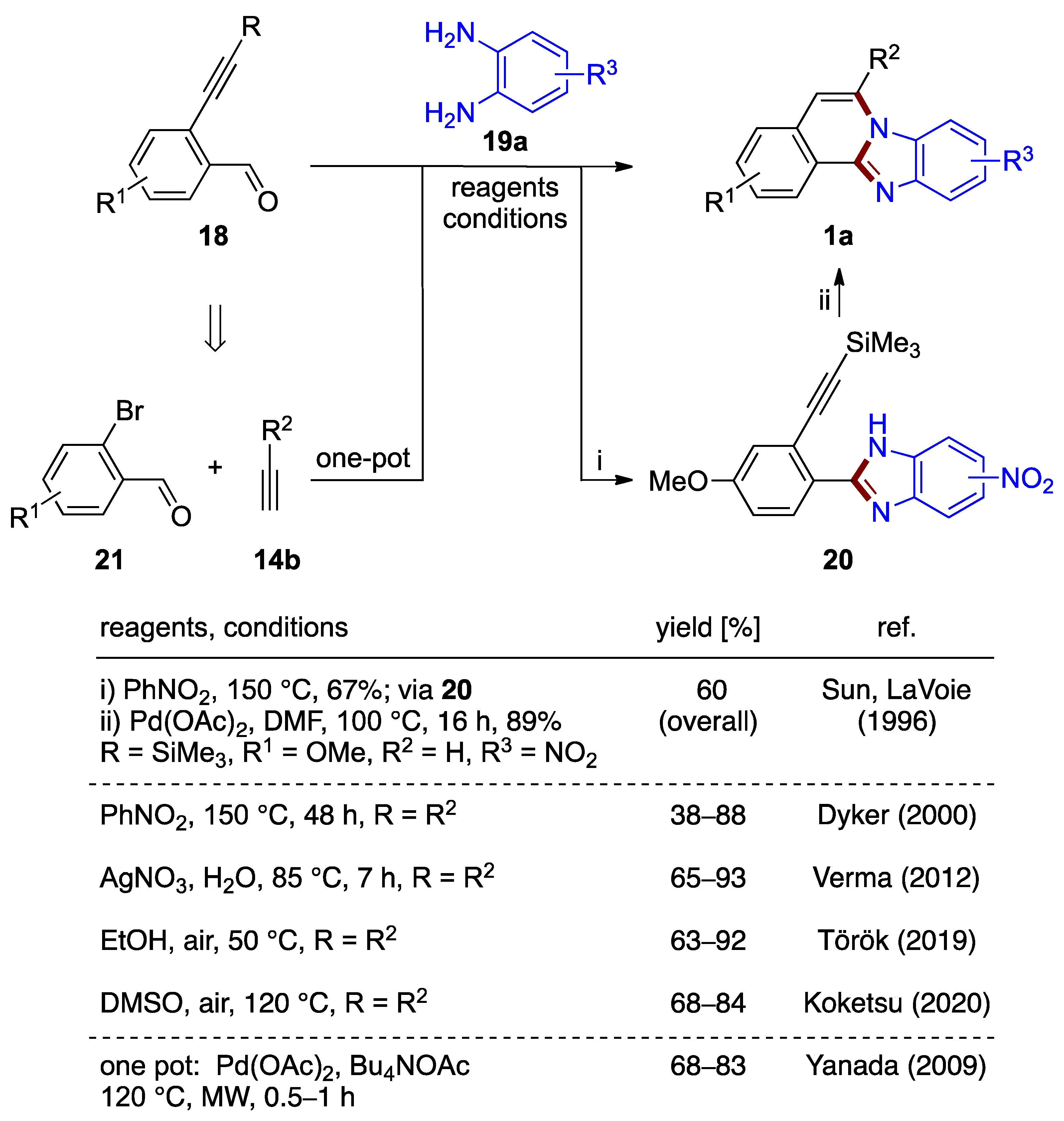

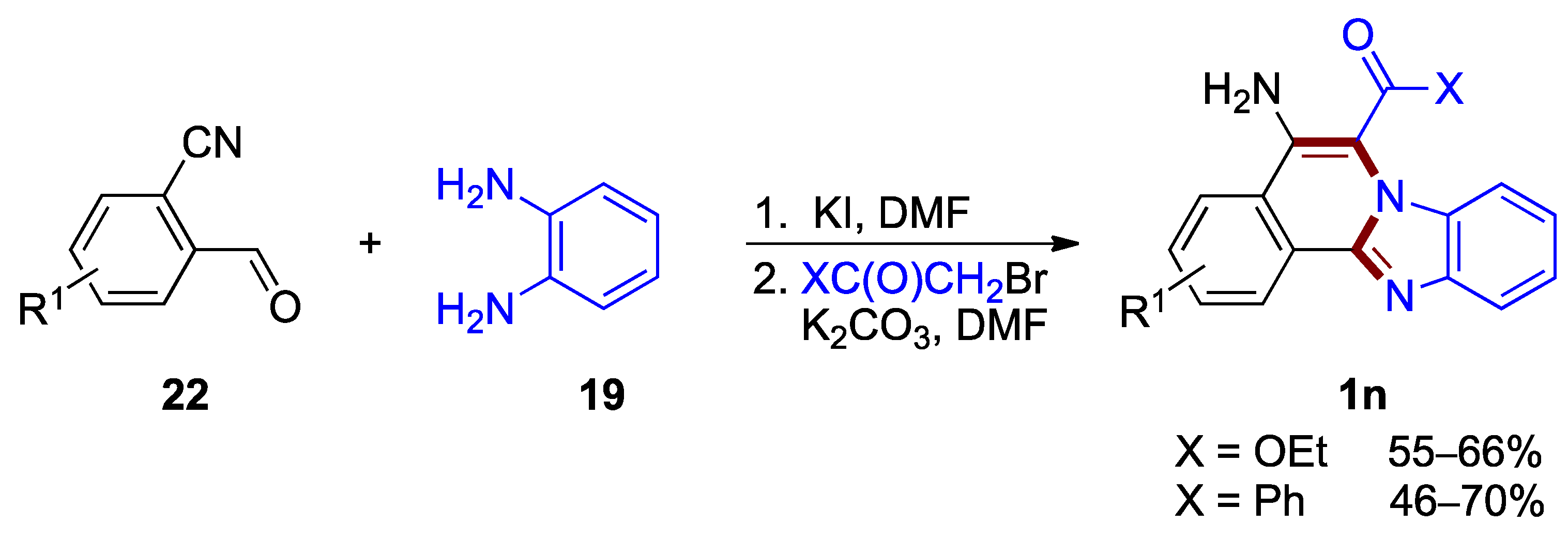

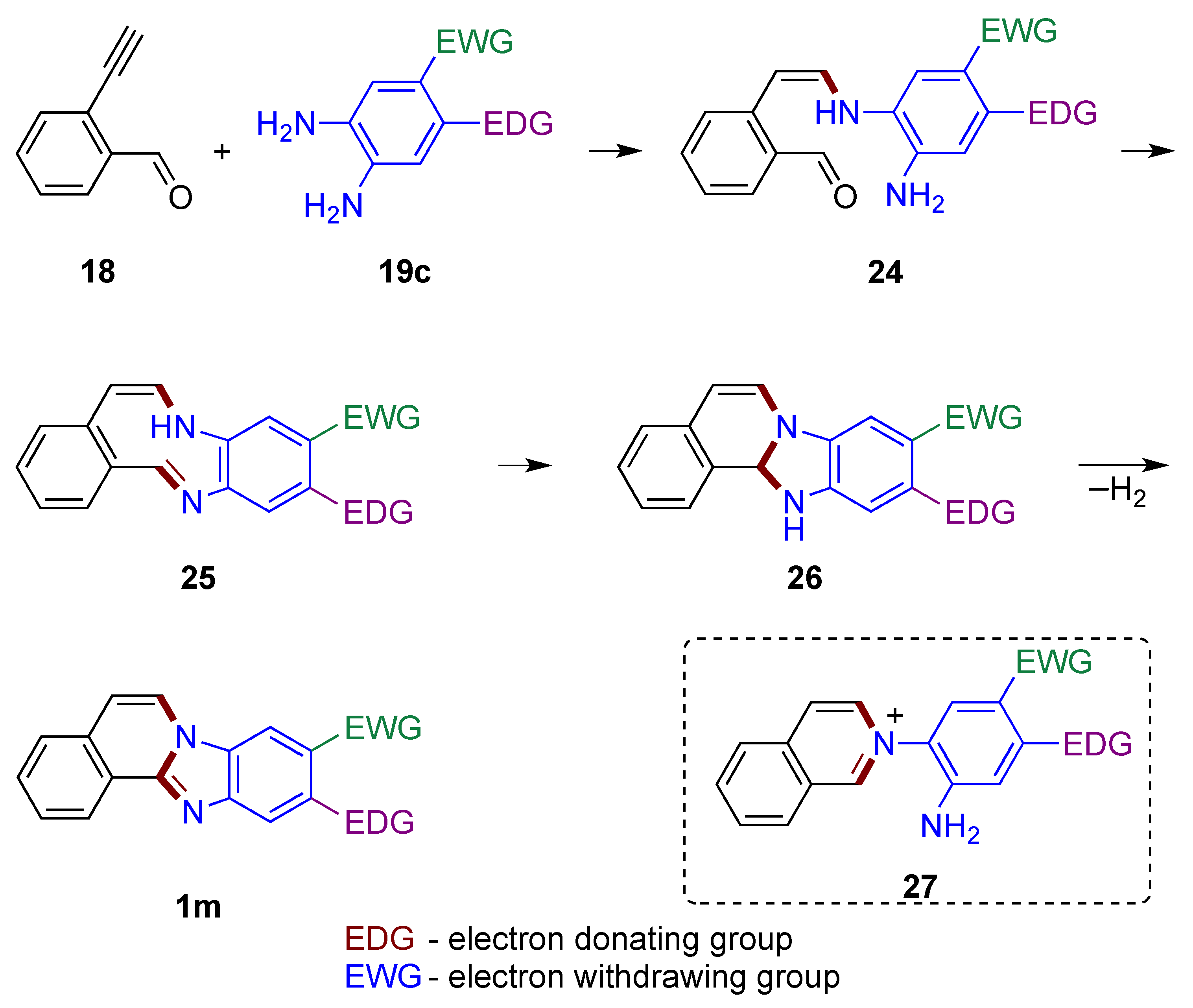


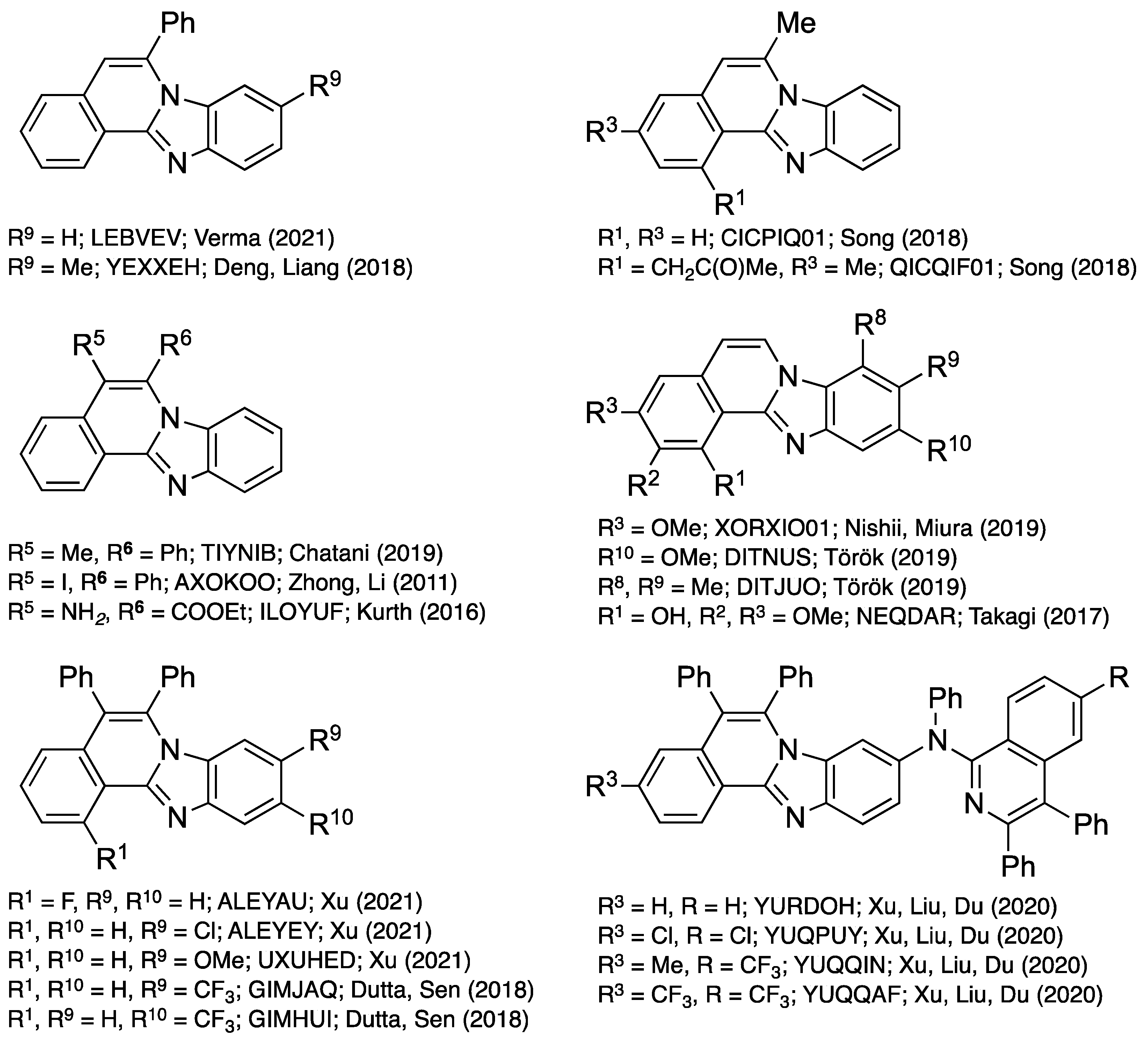
| Bond | Bond Length Min/Max [Å] | Bond Average [Å] | |
|---|---|---|---|
| C1–C2 | 1.363(4) | 1.386(5) | 1.38 |
| C2–C3 | 1.328(3) | 1.427(5) | 1.40 |
| C3–C4 | 1.34(1) | 1.388(5) | 1.37 |
| C4–C4a | 1.397(6) | 1.441(5) | 1.41 |
| C4a–C12b | 1.39(2) | 1.430(4) | 1.41 |
| C4a–C5 | 1.407(4) | 1.464(2) | 1.44 |
| C5–C6 | 1.327(8) | 1.385(2) | 1.35 |
| C6–N7 | 1.385(2) | 1.418(2) | 1.40 |
| N7–C12a | 1.377(2) | 1.418(4) | 1.40 |
| N7–C7a | 1.388(2) | 1.412(5) | 1.40 |
| C7a–C11a | 1.392(4) | 1.43(1) | 1.40 |
| C7a–C8 | 1.380(4) | 1.440(5) | 1.40 |
| C8–C9 | 1.367(4) | 1.40(1) | 1.38 |
| C9–C10 | 1.38(1) | 1.421(5) | 1.40 |
| C10–C11 | 1.362(4) | 1.393(5) | 1.38 |
| C11–C11a | 1.387(5) | 1.411(4) | 1.40 |
| C11a–N12 | 1.364(4) | 1.400(4) | 1.38 |
| N12–C12a | 1.307(3) | 1.344(3) | 1.32 |
| C12a–C12b | 1.426(2) | 1.450(2) | 1.44 |
| C12b–C1 | 1.38(2) | 1.421(2) | 1.40 |
Publisher’s Note: MDPI stays neutral with regard to jurisdictional claims in published maps and institutional affiliations. |
© 2022 by the authors. Licensee MDPI, Basel, Switzerland. This article is an open access article distributed under the terms and conditions of the Creative Commons Attribution (CC BY) license (https://creativecommons.org/licenses/by/4.0/).
Share and Cite
Twardy, D.J.; Wheeler, K.A.; Török, B.; Dembinski, R. Recent Advances in the Synthesis of Isoquinoline-Fused Benzimidazoles. Molecules 2022, 27, 2062. https://doi.org/10.3390/molecules27072062
Twardy DJ, Wheeler KA, Török B, Dembinski R. Recent Advances in the Synthesis of Isoquinoline-Fused Benzimidazoles. Molecules. 2022; 27(7):2062. https://doi.org/10.3390/molecules27072062
Chicago/Turabian StyleTwardy, Dylan J., Kraig A. Wheeler, Béla Török, and Roman Dembinski. 2022. "Recent Advances in the Synthesis of Isoquinoline-Fused Benzimidazoles" Molecules 27, no. 7: 2062. https://doi.org/10.3390/molecules27072062






